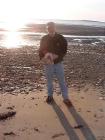15
700 Year Old Walrus Skull14 September 2004
Dr. Henry N. Payne Community Museum, Cow Head, Newfoundland

16
Walrus SkullThis skull washed up on the beach in Cow Head and was found by a gentleman in 1993.
It is the skull of a female Atlantic Walrus and isotope dating shows that she lived about 700 years ago. The tusks are quite worn and a hole above her right tusk is probably the result of a large abcess which may have led to an infection which caused her death.
Walrus were quite common in this area and tusks and bones have been found along the coast. An account from the mid 1800's mentions Cow Head fishermen using the tusks for oar locks in their boats. It was probably one of the few places in the world where fisherman used ivory oarlocks.
18
In 1919 a road was widened from the head to the mainland and the remains of the two murdered men were uncovered. Buried with the bodies was the axe.19
DOUBLE AXE MURDERA story we do not take great pride in but is nevertheless part of our history is the double axe murder.
In 1809, before Cow Head was settled, a gruesome murder took place here. According to court transcripts we were referred to at that time as Shallow Bay.
Trading stations opened in Bonne Bay in the early 1800's and people were hired as furriers to go out to the countryside and trap.
John Pelley(referred to by the local people as
"old Peely")was one of those hired. We are told he came from Ireland, not as a regular immigrant but as a fugitive from justice. John Pelley came to Shallow Bay.
Two other furriers from Rocky Harbour,Joseph Rendell and Richard Cross also came to Shallow Bay. We do not know if Pelley felt they were encroaching on his traplines or as some stories say, one of the men may have been planning to cut a boat timber. Whatever the reason being, John Pelley murdered both men.
Sarah Singleton became worried when her brother and fiance had not returned so her and a gentleman by the name of John Paine walked to Shallow Bay to look for her brother and his companion. They were suspicious when Sarah saw blood, even though Pelley swore he had not seen the two men. They returned to Rocky Harbour to gather more people and returned to Shallow Bay.
The search party came and located Pelley. He confessed to the murders and was taken to Bonne Bay and then on to St. John's. A trial was held and Pelley was hanged for his crime.
Copies of the court transcript and the axe reside at the Dr. Henry N. Payne Community Museum in Cow Head. A production of this story,"The Double Axe Murder" can be seen at the Gros Morne Threatre Festival, Cow Head during the summer months.
21
Tombstone of Mary PayneMary died at the age of 69
It is believed that John and Mary married in 1810.
22
Our First SettlersJohn Charles and Mary Payne
It is believed that John or Charles or John Charles Payne came from Christchurch, Hampshire, England. It was once thought he married his wife Mary Brooks before he came to Newfoundland. Others now believe that Mary came from the Bay of Islands and was indeed a Park whose mother married a Brooks in a second marriage. However they met, it is believed that John used Burin as a winter base and came to Cow Head to fish in the spring and returned to Burin in the fall. At that time Cow Head was part of the French Shore and was only inhabited during the fishing season.
In 1816 , on one of their trips to Cow Head a son Charles was born and John Charles and Mary decided to winter in Cow Head and made their home in Tucker's Cove.
24
Cow Head Summerside26
Cow Head Winterside27
Winterside and SummersideThe community of Cow Head formerly consisted of two parts. Winterside on the mainland and Summerside on the peninsula or "the head". The head and the mainland are connected by a natural isthmus we call "the Sandbank".
Each spring the families on Winterside moved their belongings to their summer houses on "the Head" and returned in the fall when the fishing season ended.
The Head was the center of all fishing activity and was the site of the school chapel, telegraph office and several businesses.
In 1968 , under the Fisheries Resettlement Program 24 families remaining on Cow Head Summerside were relocated to Winterside and "the Head" is now being used mainly as a fishing village.




